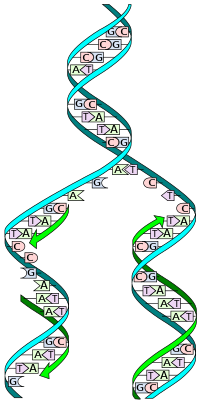
Photo from wikipedia
Membrane protein engineering exhibits great potential for cell functionalization. Although genetic strategies are sophisticated for membrane protein engineering, there still exist some issues, including transgene insertional mutagenesis, laborious, complicated procedures,… Click to show full abstract
Membrane protein engineering exhibits great potential for cell functionalization. Although genetic strategies are sophisticated for membrane protein engineering, there still exist some issues, including transgene insertional mutagenesis, laborious, complicated procedures, and low tunability. Herein, we report a DNA-templated anchoring of exogenous proteins on living cell membranes to realize programmable functionalization of living cells. Using DNA as a scaffold, the model cell membranes are readily modified with proteins, on which the density and ratio of proteins as well as their interactions can be precisely controlled through predictable DNA hybridization. Then, the natural killer (NK) cells were engineered to gain the ability to eliminate the immune checkpoint signaling at the NK-tumor synapse, which remarkably promoted NK cell activation in immunotherapy. Given the versatile functions of exogenous proteins and flexible designs of programmable DNA, this method has the potential to facilitate membrane-protein-based cell engineering and therapy.
Journal Title: Nano letters
Year Published: 2022
Link to full text (if available)
Share on Social Media: Sign Up to like & get
recommendations!